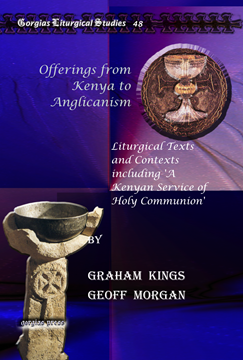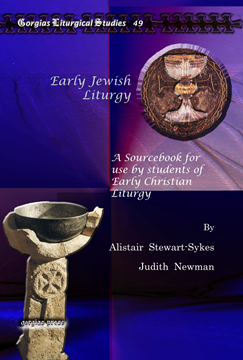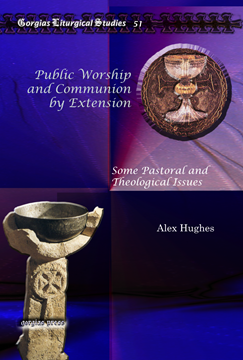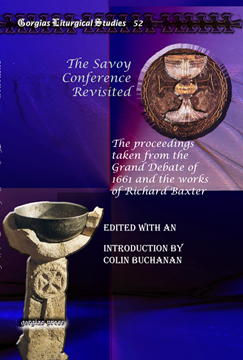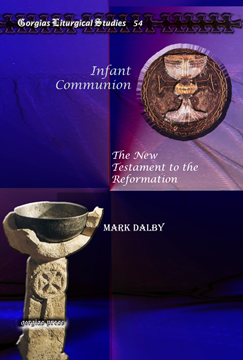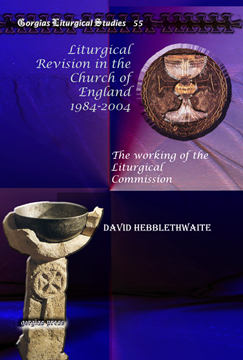Offerings from Kenya to Anglicanism
Liturgical Texts and Contexts including 'A Kenyan Service of Holy Communion'
By Graham Kings & Geoff Morgan
Series: Kiraz Liturgical Studies 48
ISBN: 978-1-60724-399-1
The 1989 Kenyan eucharistic text has had much publicity, including its use at the opening service of the 1998 Lambeth Conference, but has had little in the way of introduction or commentary. These two authors, with much Kenyan experience and with encouragement from the key persons in Kenya, here provide the text with a valuable contextual exposition.
$138.00 (USD) $82.80 (USD)
Early Jewish Liturgy
A Sourcebook for use by students of Early Christian Liturgy
Series: Kiraz Liturgical Studies 49
ISBN: 978-1-60724-400-4
Whereas many studies suggest or presuppose some link between Christian liturgical origins and the practices of Judaism the Jewish sources are hard to find and understand for Christian students without any background in early Judaism and its literature. This book presents some of the relevant sources in clear English, with accompanying material which sets the sources in their context and introduces the student to the debate about the relationship between Jewish and early Christian liturgy.
$110.00 (USD) $66.00 (USD)
Church and Worship in Fifth-Century Rome
The Letter of Innocent 1 to Decentius of Gubbio
Series: Kiraz Liturgical Studies 50
ISBN: 978-1-60724-401-1
The letter comes from the fourth century and is therefore very significant for studies of early Roman liturgical history - and is frequently quoted. Here the series provides the full text with translation and notes.
$138.00 (USD) $82.80 (USD)
Public Worship and Communion by Extension
Some Pastoral and Theological Issues
By Alex Hughes
Series: Kiraz Liturgical Studies 51
ISBN: 978-1-60724-402-8
A thorough look at the meaning of administering and receiving communion away from the place of a true celebration of the eucharist. Well-based theological reflections give rise to some very awkward questions for the rite and its practitioners.
$94.00 (USD) $56.40 (USD)
The Savoy Conference Revisited
The proceedings taken from the Grand Debate of 1661 and the works of Richard Baxter
Edited with an Introduction by Colin Buchanan
Series: Kiraz Liturgical Studies 52
ISBN: 978-1-60724-403-5
The records of the Savoy Conference come from seventeenth century sources, and they were edited and reproduced in two nineteenth century volumes: E.Cardwell's A History of Conferences and Other Proceedings connected with the Revision of The Book of Common Prayer; from the year 1558 to the year 1690 (1841, and 2nd ed. 1849) and G.Gould, Documents relating to the Settlement of the Church of England by the Act of Uniformity of 1662 (London, 1862). Both present the Presbyterians' 'Exceptions' tabled at the Savoy Conference in 1661, and the Bishops' (somewhat unyielding) Answers to the Exceptions - but neither editor brings the texts together. This Joint Study presents the General Exceptions in parallel column with their respective Answers.
$140.00 (USD) $84.00 (USD)
Sequential or Direct Ordination?
A return to the Sources
Series: Kiraz Liturgical Studies 53
ISBN: 978-1-60724-404-2
In the Anglican Communion, the medieval practice, which certainly had some earlier roots, continued—that ordination came to any one individual in this 'sequence': deacon, presbyter, bishop. The Anglican ordinal was so committed to this pattern at the Reformation that Cranmer's text prayed that deacons 'may so well use themselves in this inferior office, that they may be found worthy to be called unto higher ministries in thy Church.' Latterly, however, Anglicans have not only sought to develop the calling of a deacon in his or her own right, but have in some places and cases promoted the idea that the true calling of a deacon and of a presbyter would be best clarified by a separate 'direct' ordination. John Gibaut, a liturgical theologian of the Anglican Church of Canada, presents the case for 'direct' ordination—rooting it in the patristic era, and spelling out its implications in the present day.
$138.00 (USD) $82.80 (USD)
Infant Communion
The New Testament to the Reformation
By Mark Dalby
Series: Kiraz Liturgical Studies 54
ISBN: 978-1-60724-405-9
The communion of infants is different from the admission of children at, say, seven or eight. Both practices traditionally require baptism, and either may require confimation/chrysmation as well. But infant communion never requires a measure of 'understanding', whereas child communion does. As yet there is no comprehensive history of infant communion. Several learned attempts were made during the seventeenth and eighteenth centuries, but there were major gaps in their treatment and much that today needs amending. Thanks to the work of JDC Fisher and DR Holeton, many of these gaps have now been filled. I have drawn significantly on their work, as well as on an article of my own in CQR in 1966, but I have also sought to fill in more of the gaps.
$138.00 (USD) $82.80 (USD)
Liturgical Revision in the Church of England 1984-2004
The working of the Liturgical Commission
Series: Kiraz Liturgical Studies 55
ISBN: 978-1-60724-406-6
The liturgy of the Church of England is primarily located in The Book of Common Prayer (1662), but from the mid-20th century it has been enriched and supplemented by a range of authorized alternative services. Most of these were initially collected in The Alternative Service Book 1980 (ASB). From 1986 to 2005 there was a comprehensive revision and enlargement in the scope of alternative services. These, combined with the main elements of the 1662 tradition, are now published in Common Worship. The planning, drafting and processing of this work lay with the Liturgical Commission of the Church of England, and JLS 57 charts the separate but interlocking processes which this involved from the perspective of the Commission's Secretary and chronicler throughout the period 1984-2002.
$138.00 (USD) $82.80 (USD)
Celebrating Forgiveness
An original text drafted by Michael Vasey
Series: Kiraz Liturgical Studies 56
ISBN: 978-1-60724-348-9
This Liturgical Study is dedicated to the memory of Michael Vasey, liturgy tutor at St John's College, Durham (1975-1998), and a member of the Church of England's Liturgical Commission (1985-1998), who died in June 1998. It reproduces the text which he originally drafted for the Commission in the early 1990s, as amended both by the Commission and by the House of Bishops, on which discussion was effectively suspended in 1995. At that stage the Commission propsed to further the discussion on penitence and reconciliation in the church by publishing its proposed text together with some background essays, but the project, which Michael was to have edited, was halted by his untimely death.
$138.00 (USD) $82.80 (USD)
Language, Liturgy and Meaning
Series: Kiraz Liturgical Studies 57
ISBN: 978-1-60724-349-6
An intellectual exploration of language and liturgy and how both of them participate in the articulation of meaning.
$110.00 (USD) $66.00 (USD)
